Three Doors + Hatch + Turbo = Fun
Three-door hatch? Yep, one big door on the driver’s side and two smaller doors for passengers. Toss in the rear hatch and the 2017 Hyundai Veloster Turbo makes for a spirited little four-door that seats two adults comfortably, and, with the rear seat folded flat, has space to haul all the luggage you need for your next road trip.
The 2017 Veloster Turbo is powered by a 1.6-liter turbo that produces 201 horsepower (hp) and 195 pounds-feet (lb.-ft.) of torque, while running on 87 octane gasoline. Clean Fleet Report’s front-wheel drive test car was equipped with a six-speed manual transmission. The same powertrain shows up on the Veloster Turbo R-Spec model. The Veloster Turbo has an optional seven-speed dual clutch automatic with paddle shifters.
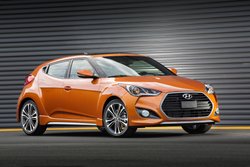
So how do these engine and transmissions affect fuel economy? The EPA rating on our Veloster Turbo 6M/T was 25 city/33 highway/28 combined. Had our car been equipped with the seven-speed automatic, the EPA estimates are 26/32/29. These EPA estimates are the same for the Veloster Turbo R-Spec. In 280 miles of driving throughout Southern California–mostly on highways–Clean Fleet Report averaged 27.7 mpg.
For comparison, if you chose the Veloster Base or Value Edition models, they are powered by a 1.6-liter four-cylinder non-turbo that puts out 132 hp and 120 lb.-ft. of torque. The EPA fuel rating for these are 28 city/35 highway/31 combined. Therefore, opting for the turbocharged engine, that gives better performance, is a viable option considering there is nominal fuel economy difference between the turbo and non-turbo engines.
The beauty of a small displacement engine is the potential high fuel mileage numbers. But, if you spend most of your time in the city, rush hour freeway traffic or bopping around on mountain roads, the manual transmission will make your drive more spirited. That leads to sipping more gasoline. So, if your driving pattern is the stuck-in-traffic type, as opposed to finding a twisty and curvy road, then go with the automatic transmission. Your left leg will love you.
Driving Experience: On the Road
Zero to 60 in about seven seconds is respectable. The engine is smooth without a sense of any turbo lag. Hyundai says the peak torque is between 1,750-4,500 rpm, but we thought it was more impressive a bit higher. Get the car out on the freeway at 65 mph, downshift from 6th into 4th gear, the tach jacks to 4,500 rpm and the 1.6L turbo pulls hard to the 7,000 rpm red line. Clean Fleet Report’s favorite manual transmission comes on the Mazda MX-5 Miata, but the Veloster Turbo’s isn’t far behind as it went through the gears smoothly with short throws. The clutch had a very short learning curve, so around town we had no engine lugging; going from gear-to-gear was easy.

The ride was even and stable with only the Southern California concrete-grooved freeway pavement causing some harshness and choppiness, noticeable from the rear suspension. Weighing in at 3,858 lbs., the steering was a bit heavy at slow speeds, but that sensation went away at higher speeds. The Veloster Turbo was pretty nimble taking mountain curves. Contributing to the sprightly handling were standard 18-inch alloy wheels and 225/40-R18 all-season tires, plus a rack and pinion with an electric motor steering system. Front independent MacPherson struts, rear coupled torsion beam suspension and gas-filled shocks all-around complete the package. Technology also was a part of the ride and handling with electronic stability control and vehicle stability management.
The Veloster Turbo sits low to the ground, lending itself to tight cornering and quick maneuvers. Body roll or the feeling of leaning when pushing the limits on higher speed corners was minimal, but a couple of times we did feel the car wanting to step out when the corner camber went from banked to flat. At freeway speeds the Veloster Turbo gets a high passing grade for a comfortable ride and low road and wind noise.
Stopping comes from vented front and solid rear disc brakes, with ABS and brake assist. Rear disc brakes on a car of this size is a rarity. The stops were straight and, after repeated stops from 60 mph, there was no pedal fade.
Driving Experience: Exterior
The distinctive Veloster Turbo has a very recognizable look and profile, even more so for our test vehicle painted in an eye-popping Vitamin C orange. Opinions on the Veloster design are not as polarized as the Nissan Juke. While there certainly are enough folk out there that give the Veloster a thumbs sideways or down, most of the people I spoke with (including myself) thought the Veloster was a winner. It looks like a coupe, but the extra door on the passenger side (with a hidden handle) provides functionality that a small two door hatch can’t deliver. There’s also a safety factor for rear seat passengers as they enter from curbside and not in the flow of traffic.
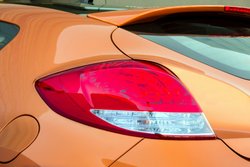
The stubby nose with a large grille, LED projector headlights and low, wide-set fog lights leads to a near-flat hood and a laid-back windshield. The meeting point of the windshield and roof is the high point on the car, with the roof then precipitously sloping to the integrated spoiler, set high above the small rear hatch window. The large LED taillights and the twin chrome exhaust tips are focal points of the rear.
Driving Experience: Interior
As with all Hyundai (and sister brand Kia) models, the car was well-built and came with many standard features. This held true for Clean Fleet Report’s 2017 Hyundai Veloster Turbo that came with the optional $2,700 Tech Package. Standard with the Turbo model is the eight-speaker Dimension premium audio system with subwoofer and amplifier, which included SiriusXM/FM/CD/AMHD with MP3 playback capability. Also part of the package were smartphone apps for Android Auto and Apple CarPlay. A seven-inch high-resolution color touchscreen display gave life to the voice-command navigation and the rear back-up camera. Bluetooth for hands-free telephone and audio operations were controlled through the multi-function steering wheel controls.
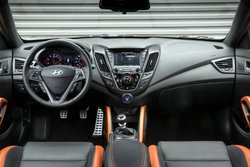
The cockpit design is driver-friendly with the gauges in easy sight and the controls handy to reach. Convenience features include power windows (with driver side auto-up/down), heated outside mirrors, a panoramic sunroof (as part of the Tech Package), USB, 115V outlet and AUX jacks. The leather-wrapped steering wheel with controls for cruise control, push button start/stop, automatic temperature control, tilt and telescopic steering column, remote keyless entry, carpeted floor mats, cargo cover and Hyundai’s Blue Link telematics add to the list of welcome features and equipment.
The side and rear sight lines are compromised by small windows and large seats/headrests. The Veloster could benefit by having blind spot detection technology that would alert when a car was in a neighboring lane.
Heated leather seats are of a sport design with wraparound wings that help hold you in place while ripping corners. The driver’s seat is six-way power adjustable, including lumbar. Other nice interior touches are piano black accents, “Turbo” seatback stitching, leather-wrapped shift knob, alloy clutch, brake and acceleration pedals, and bins and cubbies for plenty of small item storage.
While the front seat offers very good head and legroom, the rear seating area is a completely different story. Unless you are transporting children, then the best use of the 60/40 folding backseat is to lay it flat and take full advantage of the 34.7 cubic feet of storage space.
Pricing and Safety
The 2017 Hyundai Veloster comes in eight models or trim levels with base prices ranging from $18,100 to $23,800. Clean Fleet Report’s Veloster Turbo had the optional Tech Package and a MSRP of $25,425. All prices do not include the $835 freight charge.
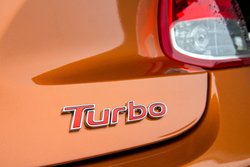
Hyundai has equipped the Veloster with active and passive safety features including six air bags, a tire pressure monitoring system, driver’s blind spot mirror, and back-up warning sensors.
The 2017 Hyundai Veloster has an Overall 5-Star National Highway Transportation Safety Association (NHTSA).
Warranties
The 2017 Hyundai Veloster comes with these warranties:
- Powertrain – 10 years/100,000 miles
- New vehicle – Five years/60,000 miles
- Roadside Assistance – Five years/60,000 miles
- Anti-Perforation – Seven years/100,000 miles
Observations: 2017 Hyundai Veloster Turbo
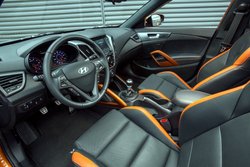
The 2017 Hyundai Veloster is fun to drive even in the base model with the non-turbo engine. Upgrade to the Turbo or the R-Spec and your driving experience begins to change, as in even more fun. The Veloster Turbo does not quite have the performance to be in the “Hot Hatch” category alongside the Volkswagen GTI, Mini Cooper S, Ford Focus RS, Subaru WRX STi or the Honda Civic Type R. However, for a bit less performance you get a fun-to-drive car that costs thousands of dollars less than these hotties. Oh, and don’t even try to compare the warranties from those others with what comes on the Veloster Turbo.
So the question becomes—are you ready to add some very reasonably priced fun to your garage? Give the Veloster Turbo a spirited test drive and see for yourself, because experiencing is believing.
Whatever you buy, Happy Driving!
Related Stories You Might Enjoy:
Road Test: 2017 Volkswagen TSI
Road Test: 2017 Mazda3 Five-Door
Road Test: 2017 Chevrolet Cruze Hatchback
Road Test: 2107 Kia Soul Turbo
Road Test: 2016 Volkswagen GLI
Disclosure:
Clean Fleet Report is loaned free test vehicles from automakers to evaluate, typically for a week at a time. Our road tests are based on this one-week drive of a new vehicle. Because of this we don’t address issues such as long-term reliability or total cost of ownership. In addition we are often invited to manufacturer events highlighting new vehicles or technology. As part of these events we may be offered free transportation, lodging or meals. We do our best to present our unvarnished evaluations of vehicles and news irrespective of these inducements.
Our focus is on vehicles that offer the best fuel economy in their class, which leads us to emphasize electric cars, plug-in hybrids, hybrids and diesels. We also feature those efficient gas-powered vehicles that are among the top mpg vehicles in their class. In addition, we aim to offer reviews and news on advanced technology and the alternative fuel vehicle market. We welcome any feedback from vehicle owners and are dedicated to providing a forum for alternative viewpoints. Please let us know your views at publisher@cleanfleetreport.com.
